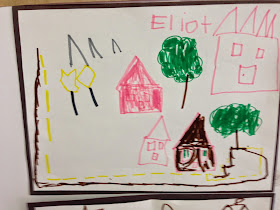Happy Summer everyone! Great to have the chance to connect with all of you again. For those new to my blog, I'm Enrique Feldman and I'm the Founder and Director of Education for the Fostering Arts-Mind Education Foundation. We work closely with MyTown in LA and together we guide thousands of parents, teachers, and children in various states and abroad.
Maps have been around for a very long time. The earliest known maps are of the heavens, not the earth. Maps dating to 16,500 BC found on the walls of the Lascaux caves, map out part of the night sky, including three bright starts, Vega, Deneb, and Altair, as well as the Pleiades star cluster. What? Is this an early childhood blog? Yes… yes, it is. While the first map was of the heavens, many of the maps I have seen children make are of places they know. Quite often, maps of where there house in relationship to other places they know, like school. At the Benson Head Start Center, they used a great prompt as you see below, along with the answers given by 4 - 5 yr olds.
Any number of questions could be asked to engage the mind of a young child related to maps and why they are used. What I love about this particular question is how open ended it was. They didn't ask a question like "Do you use Maps to find your way home?" They simply asked, "Why do people use maps?" They could also "What is a map?" This allows the learner a great deal of freedom of thought, which is related to creativity. Below is one sample map of a young child.
- What do you see?
- Is there a key being used? (wow… I think there is!)
- Based on this map, what knowledge is the child exhibiting?
- What would another potential question be in order to extend their knowledge and use of maps?
Above I mentioned creativity. In this case, I want to highlight the engagement of scientific creativity. What does that mean? The simplest way of describing this is the use of creativity with critical thinking simultaneously. According to Dr. J. H. Mathewson of the Department of Chemistry at San Diego State University, "Thinking with images plays a critical role in scientific creativity and communication but is neglected in science classroom." This comes from an article in SCIENCE EDUCATION titled "Visual-Spatial Thinking: an aspect of science overlooked by educators." Essentially, this article highlighted the effectiveness of "imagery" and building knowledge and skill in "visual-spatial cognition."
- Imagery: the formation, inspection and maintenance of images in the mind's eye without any literal visual stimulus.
- Visual-Spatial Cognition: the use of the eyes to identify, locate, and think about objects and ourselves in the world.
What may seem like a cute and simple strategy of creating maps, is in fact a scientifically proven approach to engage students of any age in ways which elevate their ability to be scientifically creative! Here is another map by a young child. Ask yourself:
- How is this map different from the previous one?
- What questions could you ask of young children to compare and contrast these two maps?
- What kind of knowledge and understanding does the maker of the map below have?
Maps create a bird's-eye view which can create new perspectives which in turn can lead to new ideas, says Dr. David Meiers, Director of the Center for Accelerated Learning in Wisconsin,and Dr. Owen Caskey, of Texas Tech University. Together they led a year long federally funded study using full-bodied imagery with college students. The results were impressive:
- Immediate recall of information: increased by 12%
- Long term recall of information: increased by 26%
With young children, think about how you could use the Art form of Embodiment to "become maps with their bodies." Children play like this already. With a sense of guidance and authentic dialogue, I have engaged young children in becoming parts of a map as a group. It's a very different perspective than drawing a map. Both the drawing of maps and the embodiment of maps compliment higher level thinking.
Related to the map below, ask yourself:
- What kind of factual information is this child showing knowledge of with his/her map?
- What kind of emotional information is this child showing knowledge of with his/her map?
- What kind of questions would you use with this child to extend the learning?
A map lights up the mind because it is essentially a picture. Anything we can visualize will stay with us for longer period of time, at any age. With that in mind, I ask you the to consider the following questions. I'm not going to answer these questions, because if I did, I'd be robbing you of the process of taking your own mental journey.
- Could a child create a map of numbers or incorporate numbers in some way?
- Could a child create a map of letter/words or incorporate letter/words in some way?
- Could a child create a map of cycles in nature?
- What would happen if we, as teachers, used more questions than exclamation points?
- What would happen if we, as teachers, used more questions than periods?
What I have been sharing with you comes from the Context Method®, which powers both MyTown and the Fostering Arts-Mind Education Foundation. I think maps are a great study and/or project for young children. I tip my hat to the teachers and children at Benson Head Start Center and I encourage you, the reader, to use map making in your work with young children.
Con un abrazo fuerte (With a big hug!),
Enrique







No comments:
Post a Comment
We would love to hear from you! Please feel free to leave a comment below....